

Owning a dog is influenced by our genetic make-up. A team of Swedish and British scientists have studied the heritability of dog ownership using information from 35,035 twin pairs from the Swedish Twin Registry.

The new study suggests that genetic variation explains more than half of the variation in dog ownership, implying that the choice of getting a dog is heavily influenced by an individual's genetic make-up. Dogs were the first domesticated animal and have had a close relationship with humans for at least 15,000 years. Today, dogs are common pets in our society and are considered to increase the well-being and health of their owners. The team compared the genetic make-up of twins (using the Swedish Twin Registry -- the largest of its kind in the world) with dog ownership.
The results are published for the first time in Scientific Reports. There Is No Such Thing as Conscious Thought. Every Single Cognitive Bias in One Infographic. The human brain can create structures in up to 11 dimensions. Neuroscientists have used a classic branch of maths in a totally new way to peer into the structure of our brains.
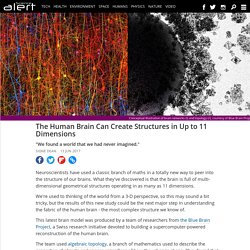
What they've discovered is that the brain is full of multi-dimensional geometrical structures operating in as many as 11 dimensions. We're used to thinking of the world from a 3-D perspective, so this may sound a bit tricky, but the results of this new study could be the next major step in understanding the fabric of the human brain - the most complex structure we know of.
Scientists Surprised to Find No Two Neurons Are Genetically Alike. The past few decades have seen intensive efforts to find the genetic roots of neurological disorders, from schizophrenia to autism.
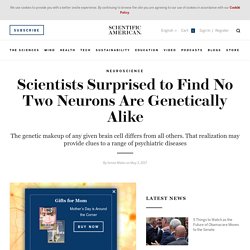
But the genes singled out so far have provided only sketchy clues. Even the most important genetic risk factors identified for autism, for example, may only account for a few percent of all cases. Much frustration stems from the realization that the key mutations elevating disease risk tend to be rare, because they are less likely to be passed on to offspring. More common mutations confer only small risks (although those risks become more significant when calculated across an entire population). There are several other places to look for the missing burden of risk, and one surprising possible source has recently emerged—an idea that overturns a fundamental tenet of biology and has many researchers excited about a completely new avenue of inquiry.
Bloated brains lay bare delicate branches of neurons. Spiny specimens: Stretching mouse tissue to 20 times its original size reveals tiny protrusions on neurons, called dendritic spines.
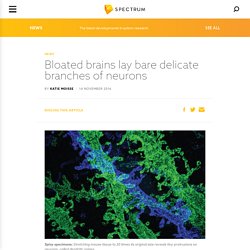
A technique that expands brain tissue to 20 times its original size lets researchers glimpse components of neurons at fine resolution. Researchers presented the unpublished method yesterday at the 2016 Society for Neuroscience annual meeting in San Diego. You Are Two. Researchers watch in 3D as neurons talk to each other in a living mouse brain. Brain at work: Neurons within a three-dimensional section of mouse brain, in a region involved in planning movement, light up as they signal to one another.
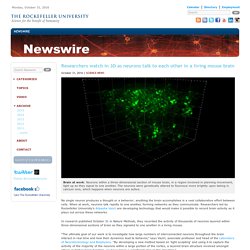
The neurons were genetically altered to fluoresce more brightly upon taking in calcium ions, which happens when neurons are active. No single neuron produces a thought or a behavior; anything the brain accomplishes is a vast collaborative effort between cells. Scientists May Have Finally Explained Déjà Vu. Researchers have a new explanation for one of the brain’s most uncanny peculiarities – the phenomenon of déjà vu.

Presenting his team’s latest work at the recent International Conference on Memory in Budapest, Akira O’Connor from the University of St Andrews described how apparent glitches in the Matrix may in fact just be the brain fact-checking its own memory system. According to New Scientist, O’Connor and his colleagues began by devising a technique to artificially trigger déjà vu. To achieve this, they presented study participants with a series of connected words, without revealing the one word that links them.
For instance, in one trial the words bed, pillow, dream and night were all presented, yet the term sleep – which clearly connects all of these words – was omitted. As such, O’Connor believes that these frontal regions probably monitor our memories as they are replayed, looking for errors in their content and becoming activated when they spot an irregularity. Metaphorically Speaking, Your Nervous System is a Dictatorship. Understanding The Spectrum - "Art is Quite useless" Fearful Experiences Passed On In Mouse Families.
The children of parents who lived through the Dutch famine of 1944 had low birth weights and suffered health problems throughout their lives, and their own children were smaller and plagued by poor health as well, studies have shown.
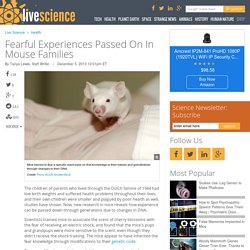
Now, new research in mice reveals how experience can be passed down through generations due to changes in DNA. Scientists trained mice to associate the scent of cherry blossoms with the fear of receiving an electric shock, and found that the mice's pups and grandpups were more sensitive to the scent, even though they didn't receive the shock training. The mice appear to have inherited the fear knowledge through modifications to their genetic code. These modifications, which can dial the expression of particular genes up or down, are known as epigenetic mechanisms. Your Memory Isn't What You Think It Is. False Memories: When Your Brain Makes Stuff Up. Correction appended 11/20/13, 10:18 AM It’s easy enough to explain why we remember things: multiple regions of the brain — particularly the hippocampus — are devoted to the job.

It’s easy to understand why we forget stuff too: there’s only so much any busy brain can handle. What’s trickier is what happens in between: when we clearly remember things that simply never happened. The phenomenon of false memories is common to everybody — the party you’re certain you attended in high school, say, when you were actually home with the flu, but so many people have told you about it over the years that it’s made its way into your own memory cache. Consciousness Works Differently Than You Think, According To This New Theory. Elections in the Brain. Neuroscience Learns What Buddhism Has Known for Ages: There Is No Constant Self. List of cognitive biases.
Cognitive biases are tendencies to think in certain ways that can lead to systematic deviations from a standard of rationality or good judgment, and are often studied in psychology and behavioral economics.
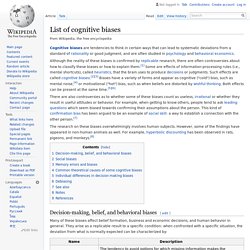
There are also controversies as to whether some of these biases count as useless, irrational or whether they result in useful attitudes or behavior. For example, when getting to know others, people tend to ask leading questions which seem biased towards confirming their assumptions about the person. Differences in Conservative and Liberal Brains - 2012 Presidential Election - ProCon.org. Are you an atheist? Then you're probably a PSYCHOPATH. If you don't believe in God or a universal spirit, you're more likely to be callous and manipulative, according to a controversial new study.
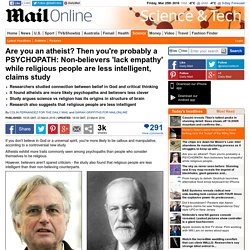
Atheists exhibit more traits commonly seen among psychopaths than people who consider themselves to be religious. However, believers aren't spared criticism - the study also found that religious people are less intelligent than their non-believing counterparts. Atheists are more likely to be psychopaths, but religious people are less intelligent, a controversial study has found. Stock images of famous atheists Richard Dawkins (left) and Sigmund Freud (right) are shown, although neither have been diagnosed as psychopaths or as having psychopathic traits Religious people were found to be more caring towards their fellow humans and the researchers believe their findings may help explain why women - who tend to be more empathetic - are also likely to be more religious. 'They actually might claim they are less intelligent.'
For The First Time, We've Seen Brand-New Neurons Firing. <img src="<a pearltreesdevid="PTD1767" rel="nofollow" href=" class="vglnk"><span pearltreesdevid="PTD1768">http</span><span pearltreesdevid="PTD1770">://</span><span pearltreesdevid="PTD1772">pixel</span><span pearltreesdevid="PTD1774">. </span><span pearltreesdevid="PTD1776">quantserve</span><span pearltreesdevid="PTD1778">. </span><span pearltreesdevid="PTD1780">com</span><span pearltreesdevid="PTD1782">/</span><span pearltreesdevid="PTD1784">pixel</span><span pearltreesdevid="PTD1786">/</span><span pearltreesdevid="PTD1788">p</span><span pearltreesdevid="PTD1790">-</span><span pearltreesdevid="PTD1792">cafODhhaQOlCs</span><span pearltreesdevid="PTD1794">.
</span><span pearltreesdevid="PTD1796">gif</span></a>" style="display:none" height="1" width="1" alt="Quantcast" /> None. Altruism may be an illusion: The neuroscience that explains our good deeds. Last December Facebook CEO Mark Zuckerberg and his wife, Priscilla Chan, announced the birth of their daughter—and made a pledge to donate 99 percent of their Facebook shares over the course of their lives to charitable causes. The decision was met with both praise for its altruism and criticism, as people called into question Zuckerberg’s true motives and whether this was a move to save millions of dollars in taxes. Of course, the world may never know whether or not the intent of the new parents was truly philanthropic.
Until now, that is. New research published this week in Science shows that by looking at how different brain regions interact, it is possible to predict whether an altruistic act is motivated by empathy or by reciprocity—a “you scratched my back, now I’ll scratch yours” situation. “Motives have a neurophysiological fingerprint,” says Ernst Fehr, a behavioral economist at the University of Zurich (U.Z.H.) and the study’s principal investigator. Your Brain Is Primed To Reach False Conclusions. Paul Offit likes to tell a story about how his wife, pediatrician Bonnie Offit, was about to give a child a vaccination when the kid was struck by a seizure. Had she given the injection a minute sooner, Paul Offit says, it would surely have appeared as though the vaccine had caused the seizure and probably no study in the world would have convinced the parent otherwise.
(The Offits have such studies at the ready — Paul is the director of the Vaccine Education Center at the Children’s Hospital of Philadelphia and author of “Deadly Choices: How the Anti-Vaccine Movement Threatens Us All.”) Parasite Hijacks Chimps' Brains And Makes Them More Likely To Be Killed By A Leopard. The host-parasite relationship is intricate and convoluted. While a parasite doesn’t usually want their host to die, for the protozoan Toxoplasma gondii it can actually be advantageous. Indeed, while the parasite needs to spend time in a feline host – be it a domestic moggy or their wild counterparts – in order to sexually reproduce, T. gondii also spends part of its life cycle in an intermediate host, which can be any mammal, from mice to humans.
Leopards are the only natural predator of chimps, and the parasite plays on this. Eduard Kyslynskyy/Shutterstock Now, when mice are infected with the parasite that then wants to get inside a cat in order to reproduce, it has to somehow bridge the gap between the natural enemies. Humans Beat Computers at Mapping Neurons. Posted 2/12/2016 The average human brain is estimated to contain between 86-100 billion neurons and 10,000 times as many synapses. In the retina, the layer of tissue at the back of the eye that receives and sends visual signals to the brain, scientists don't yet know the number and type of neurons that are connected.
Even with advances in software technology for neuron reconstruction, it would take a team of 100 people working non-stop for 500,000 years to map the neurons in one human brain. However, researchers devised a novel solution to this obstacle-using a browser-based computer game, anyone can help in neural mapping and contribute to neuroscience research. Graphene successfully interfaced with neurons in the brain. Scientists have long been on a quest to find a way to implant electrodes that interface with neurons into the human brain. If successful, the idea could have huge implications for the treatment of Parkinson's disease and other neurological disorders. Last month, a team of researchers from Italy and the UK made a huge step forward by showing that the world's favorite wonder-material, graphene, can successfully interface with neurons.
Too many neurons spoil the memory. Tell me where dwell the thoughts, forgotten till thou call them forth? DARPA researchers to push limits of reading, writing brain neurons. The Defense Advanced Research Projects Agency (DARPA) started a new project this week to dramatically increase the number of human brain neurons that can be read simultaneously, according to the MIT Technology Review. In four years, DARPA wants a breakthrough from neuroscientists that will record from 1 million neurons simultaneously. DARPA will spend $60 million under the broader Whitehouse BRAIN Initiative to fund research in the top neuroscience labs across the country.
The applications for a brain computer interface (BCI) at this point is speculative. Achieving the project goal would significantly extend scientists’ ability to understand how the brain works, and would enable high-fidelity control of robotic limb and high-resolution electronic vision prosthetics. The report didn't provide any reason for a normal person to accept such an adaption, but this research would certainly be a game-changing development in human-computer interfaces and virtual reality.
MIT Technology Review. A New Vision for Dreams of the Dying. Graphene electrodes can safely interact with neurons. Neuronal Basis Of Consciousness Explored In New Study. The Science of Healing Thoughts. For centuries, the idea of “healing thoughts” has held sway over the faithful. In recent decades it’s fascinated the followers of all manner of self-help movements, including those whose main purpose seems to be separating the sick from their money.
Matt Ridley on Twins and the Question of Inherited IQ. Keep pot away from teens, researchers urge. Revolutionary Neuroscience Technique Slated for Human Clinical Trials. A technique called optogenetics has transformed neuroscience during the past 10 years by allowing researchers to turn specific neurons on and off in experimental animals. Best and Worst of Neuroscience and Neurology – November 2015. Medscape: Medscape Access. Neuroscience explains why ISIS attracts psychopaths. Why Adorable Puppies Can Make You Feel Violent. The Brain Stimulation Program at The Johns Hopkins Hospital in Baltimore, Maryland. Warning over electrical brain stimulation. Old rat brains rejuvenated and new neurons grown by asthma drug. Study Examines Scale of Gene Mutations in Human Neurons. This Graphic Explains 20 Cognitive Biases That Affect Your Decision-Making.
The Brain-Gut Axis, Part 1 – A Paradigm Shift In Neuroscience. Researchers Create Wireless Implantable Device That Can Stimulate Neurons. Neurons’ broken machinery piles up in ALS. Activity of entire central nervous system captured on film for first time. Neurons’ broken machinery piles up in ALS. Artificial Neurons Could Replace Some Real Ones In Your Brain. Brain Synapses Last as Long as Memories do. Scientists Create Artificial Neuron that Functions Like the Real Thing. Missing link found between brain, immune system. Injectable brain implant spies on individual neurons.
Scientists Find Vessels That Connect Immune System And Brain. Researchers Find Link Between Depression And Fuzzy Thinking. This cartoon is the simplest explanation of the color-changing dress. Utah Suicides Linked to Air Pollution. This is what happens to your brain when you give up sugar. The Trouble With The DSM. Neuroscience of Marijuana Munchies. Housewife Takes LSD On Camera For the Government. Scientists Discover 'Reset' Button For Brain's Biological Clock. 2014jastreboffdst.pdf.
First Videos Created Of Whole Brain Neural Activity In An Unrestrained Animal. Conscious Brain-to-Brain Communication in Humans Using Non-Invasive Technologies. Happiness Equation Reveals Key to Cheery Life. Our godless brains: Emerging science reveals mind-blowing alternatives to a higher power. Psychologists Give People Control of Their Dreams Using Brain Stimulation. Really? Study: Violent games can desensitize players. Study: Gun homicides, violence down sharply in past 20 years. How a Brain Injury Made Me A Mathematical Marvel. Why some people remember dreams and others don't.
Through the known universe. How Sleep Deprivation Decays the Mind and Body - Seth Maxon. Phineas Gage neuroscience case: True story of famous frontal lobe patient is better than textbook accounts. 'Neurons to Nirvana' Makes the Case for Deeper Scientific Research Into Psychedelics. Brain 'rejects negative thoughts' Red makes men behave "like animals" Heaven is for neuroscience: How the brain creates visions of God. Some things ARE sacred: Scientists find different area of brain. Motivation Pathways In The Brain Can Fail And Cause Depression - Health News.
Prehistoric Human Brain Found Pickled in Bog. Move things with your mind: BrainGate robotic arm is controlled by brain waves. What Do Your Dreams Mean? Here’s How You Can Decode Them. Discovery of quantum vibrations in 'microtubules' inside brain neurons supports controversial theory of consciousness. Animal Intelligence Under-rated By Humans, Researchers Say. The Neuroscience of Your Brain On Fiction. Leap forward in brain-controlled computer cursors: New algorithm greatly improves speed and accuracy. Freud’s Theory of Unconscious Conflict Linked to Anxiety Symptoms.